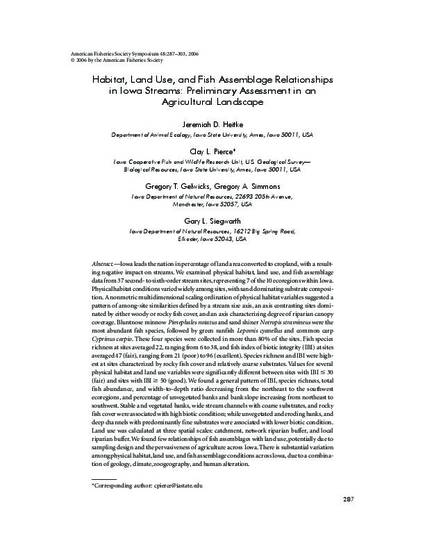
Iowa leads the nation in percentage of land area converted to cropland, with a resulting negative impact on streams. We examined physical habitat, land use, and fish assemblage data from 37 second- to sixth-order stream sites, representing 7 of the 10 ecoregions within Iowa. Physical habitat conditions varied widely among sites, with sand dominating substrate composition. A nonmetric multidimensional scaling ordination of physical habitat variables suggested a pattern of among-site similarities defined by a stream size axis, an axis contrasting sites dominated by either woody or rocky fish cover, and an axis characterizing degree of riparian canopy coverage. Bluntnose minnow Pimephales notatus and sand shiner Notropis stramineus were the most abundant fish species, followed by green sunfish Lepomis cyanellus and common carp Cyprinus carpio. These four species were collected in more than 80% of the sites. Fish species richness at sites averaged 22, ranging from 6 to 38, and fish index of biotic integrity (IBI) at sites averaged 47 (fair), ranging from 21 (poor) to 96 (excellent). Species richness and IBI were highest at sites characterized by rocky fish cover and relatively coarse substrates. Values for several physical habitat and land use variables were significantly different between sites with IBI 30 (fair) and sites with IBI 50 (good). We found a general pattern of IBI, species richness, total fish abundance, and width-to-depth ratio decreasing from the northeast to the southwest ecoregions, and percentage of unvegetated banks and bank slope increasing from northeast to southwest. Stable and vegetated banks, wide stream channels with coarse substrates, and rocky fish cover were associated with high biotic condition; while unvegetated and eroding banks, and deep channels with predominantly fine substrates were associated with lower biotic condition. Land use was calculated at three spatial scales: catchment, network riparian buffer, and local riparian buffer. We found few relationships of fish assemblages with land use, potentially due to sampling design and the pervasiveness of agriculture across Iowa. There is substantial variation among physical habitat, land use, and fish assemblage conditions across Iowa, due to a combination of geology, climate, zoogeography, and human alteration.
Available at: http://works.bepress.com/clay_pierce/21/

This article is from American Fisheries Society Symposium 48 (2006): 287.